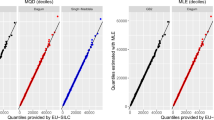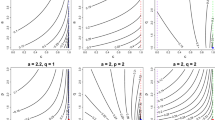Abstract
Dagum and Singh–Maddala distributions have been widely assumed as models for income distribution in empirical analyses. The properties of these distributions are well known and several estimation methods for these distributions from grouped data have been discussed widely. Moreover, previous studies argue that the Dagum distribution gives a better fit than the Singh–Maddala distribution in the empirical analyses. This study explores the reason why Dagum distribution is preferred to the Singh–Maddala distribution in terms of the akaike information criterion through Monte Carlo experiments. In addition, the properties of the Gini coefficients and the top income shares from these distributions are examined by means of root mean square errors. From the experiments, we confirm that the fit of the distributions depends on the relationships and magnitudes of the parameters. Furthermore, we confirm that the root mean square errors of the Gini coefficients and top income shares depend on the relationships of the parameters when the data-generating processes are a generalized beta distribution of the second kind.



Similar content being viewed by others
Notes
Kakamu and Nishino (2014) show that the estimates of the generalized beta (GB) distribution do not change, even if the number of groups is different when a Markov chain Monte Carlo (MCMC) method is utilized. Therefore, we also utilize the MCMC method to estimate the parameters of the models.
It is desirable to use the maximum likelihood estimates to calculate the Gini coefficients. However, as stated in the Appendix, it is sometimes difficult to find the mode of parameters by the maximum likelihood estimates when we assume the Dagum and Singh–Maddala distributions are the income distribution. This is another reason why we use the MCMC method.
Once the parameters are estimated, we could calculate the Gini coefficients from the parameters. The Gini coefficients from the Dagum and Singh–Maddala distributions are expressed by
$$\begin{aligned} G_{DA}= & {} \frac{{\varGamma }(p){\varGamma }(2p + 1/a)}{{\varGamma }(2p){\varGamma }(p + 1/a)} - 1,\\ G_{SM}= & {} 1 - \frac{{\varGamma }(q){\varGamma }(2q - 1/a)}{{\varGamma }(q-1){\varGamma }(2q)}, \end{aligned}$$where \({\varGamma }(\cdot )\) is a gamma function.
Moreover, \(\chi \)% top income share from these distributions, where \(\chi = 100 \times (1 - z)\), are expressed by
$$\begin{aligned} T_{DA, \chi }= & {} 1 - I_{t}(p + 1/a, 1 - 1 / a),\ \text {where }t = z^{1/p}\\ T_{SM, \chi }= & {} 1 - I_{t}(1 + 1/a, q - 1 / a),\ \text {where }t = 1 - (1 - z)^{1/q}, \end{aligned}$$where \(I_{x}(a,b)\) is the incomplete beta function ratio. In this study, we focus on 10 % (\(z= 0.9\)) top income shares.
Some modifications are required to estimate the parameters. Therefore, the details of the modified algorithm are summarized in the Appendix.
To generate a random number from GB2 with parameters a, b, p, and q, we first generate Z from a beta distribution with parameters p and q. Then, \(\displaystyle X = b \left( \frac{Z}{1 - Z} \right) ^{\frac{1}{a}}\) becomes the random number from the GB2 distribution. In addition, the Gini coefficient from the GB2 distribution is as follows
$$\begin{aligned} G_{\textit{GB2}}= & {} \frac{B(2 p + 1 / a, 2 q - 1 / a)}{B(p, q) B(p + 1 / a, q - 1 / a)}\\&\times \left[ \frac{1}{p}{}_{3}F_{2}(1, p + q, 2 p + 1 / a ; p + 1 + 1 / a, 2 (p + q) ; 1) \right. \\&\left. - \frac{1}{p + 1 / a} {}_{3}F_{2}(1, p + q, 2 p + 1 / a ; p + 1 + 1 / a, 2 (p + q) ; 1) \right] , \end{aligned}$$where \({}_{3}F_{2}\) is a hypergeometric function. However, we calculate the Gini coefficient as well as the top income share by the numerical integration for the same reason as Hajargasht et al. (2012). Moreover, we examine several different values of a and b. However, as similar tendencies can be found, we focus on the cases of \(a = 3.0\) and \(b = 6.0\).
The detailed tables, which are the source of the figures, are available upon request from the author.
References
Atkinson, A. B., Piketty, T., & Saez, E. (2011). Top incomes in the long run of history. Journal of Economic Literature, 49, 3–71.
Atoda, N., Suruga, T., & Tachibanaki, T. (1988). Statistical inference of functional forms for income distribution. Economic Studies Quarterly, 39, 14–40.
Brzezinski, M. (2013). Asymptotic and bootstrap inference for top income share. Economics Letters, 120, 10–13.
Chib, S., & Jeliazkov, I. (2001). Marginal likelihood from the Metropolis–Hastings output. Journal of the American Statistical Association, 96, 270–281.
Chotikapanich, D., & Griffiths, W. E. (2000). Posterior distributions for the Gini coefficient using grouped data. Australian and New Zealand Journal of Statistics, 42, 383–392.
Dagum, C. (1977). A new model of personal income distribution: Specification and estimation. Économie Appliquée, 30, 413–437.
Doornik, J. A. (2009). Ox: An object oriented matrix programming language. London: Timberlake.
Gelfand, A. E., Hills, S. E., Racine-Poon, A., & Smith, A. F. M. (1990). Illustration of Bayesian inference in normal data models using Gibbs sampling. Journal of the American Statistical Association, 85, 972–985.
Goffe, W. L., Ferrier, G. D., & Rogers, J. (1994). Global optimization of statistical functions with simulated annealing. Journal of Econometrics, 60, 65–99.
Hajargasht, G., Griffiths, W. E., Brice, J., Rao, D. S. P., & Chotikapanich, D. (2012). Inference for income distributions using grouped data. Journal of Business & Economic Statistics, 30, 563–575.
Johnson, V. (2004). A Bayesian \(\chi ^{2}\) test for goodness-of-fit. Annals of Statistics, 32, 2361–2384.
Kakamu, K., & Nishino, H. (2014). Bayesian estimation of beta type distribution parameters based on grouped data. mimeo.
Kleiber, C. (1996). Dagum vs. Singh–Maddala income distributions. Economics Letters, 53, 265–268.
Kleiber, C. (2008). A guide to the Dagum distributions. In D. Chotikapanich (Ed.), Modelling income distributions and Lorenz curves (pp. 97–117). New York: Springer.
Kleiber, C., & Kotz, S. (2003). Statistical size distributions in economics and actuarial science. New York: Wiley.
Majumder, A., & Chakravarty, S. R. (1990). Distribution of personal income: Development of a new model and its application to US income data. Journal of Applied Econometrics, 5, 189–196.
McDonald, J. B. (1984). Some generalized functions for the size distribution of income. Econometrica, 52, 647–663.
McDonald, J. B., & Mantrala, A. (1995). The distribution of personal income: Revisited. Journal of Applied Econometrics, 10, 201–204.
McDonald, J. B., & Ransom, M. R. (1979a). Functional forms, estimation techniques and the distribution of income. Econometrica, 47, 1513–1525.
McDonald, J. B., & Ransom, M. R. (1979b). Alternative parameter estimators based upon grouped data. Communications in Statistics, A8, 899–917.
Nishino, H., & Kakamu, K. (2011). Grouped data estimation and testing of Gini coefficients using lognormal distributions. Sankhya Series B, 73, 193–210.
Nocedal, J., & Wright, S. J. (2000). Numerical optimization (2nd ed.). New York: Springer.
Reed, W. J., & Jorgensen, M. (2013). The double Pareto-lognormal distribution–a new parametric model for size distributions. Communications in Statistics, Theory and Methods, 33, 1733–1753.
Singh, S. K., & Maddala, G. S. (1976). A function for size distribution of income. Econometrica, 44, 963–970.
Tadikamalla, P. R. (1980). A look at the Burr and related distributions. International Statistical Review, 48, 337–344.
Acknowledgments
I would like to thank an anonymous referee and the editor of this journal for their valuable comments and suggestions, which improve the paper substantially. This work is supported partially by KAKENHI (#26380266, #24530222, and #25245035).
Author information
Authors and Affiliations
Corresponding author
Appendix: Markov chain Monte Carlo Methods
Appendix: Markov chain Monte Carlo Methods
In this appendix, we introduce a Markov chain Monte Carlo (MCMC) method to estimate the parameters of the distributions, which is proposed by Chotikapanich and Griffiths (2000) for the Singh–Maddala distribution. As the estimation procedure of the Dagum distribution is the same as that of the Singh–Maddala distribution, we continue the explanation focusing on the Singh–Maddala distribution.
Chotikapanich and Griffiths (2000) first proposed the MCMC method to estimate the parameters of the distribution from grouped data using a random walk Metropolis–Hastings (RWMH) algorithm. However, it is sometimes difficult to estimate the parameters using their algorithm. Therefore, some modifications are required. Their algorithm with some modifications is as follows.
-
1.
Generate a candidate value \({\varvec{\theta }}_{SM}^{new}\) from \(\mathcal {N}({\varvec{\theta }}_{SM}^{(m-1)}, c^{2} \varvec{\Sigma })\), where c is a tuning parameter and \(\varvec{\Sigma }\) is the maximum likelihood covariance estimate.Footnote 7
-
2.
Compute
$$\begin{aligned} \alpha \left( {\varvec{\theta }}_{SM}^{(m-1)}, {\varvec{\theta }}_{SM}^{new} \right) = \min \left\{ 1, \frac{ \pi ( {\varvec{\theta }}_{SM}^{new} | \mathbf {x}) }{\pi ( {\varvec{\theta }}_{SM}^{(m - 1)} | \mathbf {x}) } \right\} , \end{aligned}$$and if any of the elements of \({\varvec{\theta }}_{SM}^{new}\) fall outside the feasible parameter region, then \(\alpha \left( {\varvec{\theta }}_{SM}^{(m-1)}, {\varvec{\theta }}_{SM}^{new} \right) = 0\).
-
3.
Generate a value u from \(\mathcal {U}(0,1)\), where \(\mathcal {U}(a,b)\) is a uniform distribution on the interval (a, b).
-
4.
If \(u \le \alpha \left( {\varvec{\theta }}_{SM}^{(m-1)}, {\varvec{\theta }}_{SM}^{new} \right) \), set \({\varvec{\theta }}_{SM}^{(m)} = {\varvec{\theta }}_{SM}^{new}\), otherwise \({\varvec{\theta }}_{SM}^{(m)} = {\varvec{\theta }}_{SM}^{(m-1)}\).
-
5.
Return to step 1, with m set to \(m+1\).
Rights and permissions
About this article
Cite this article
Kakamu, K. Simulation Studies Comparing Dagum and Singh–Maddala Income Distributions. Comput Econ 48, 593–605 (2016). https://doi.org/10.1007/s10614-015-9538-z
Accepted:
Published:
Issue Date:
DOI: https://doi.org/10.1007/s10614-015-9538-z




